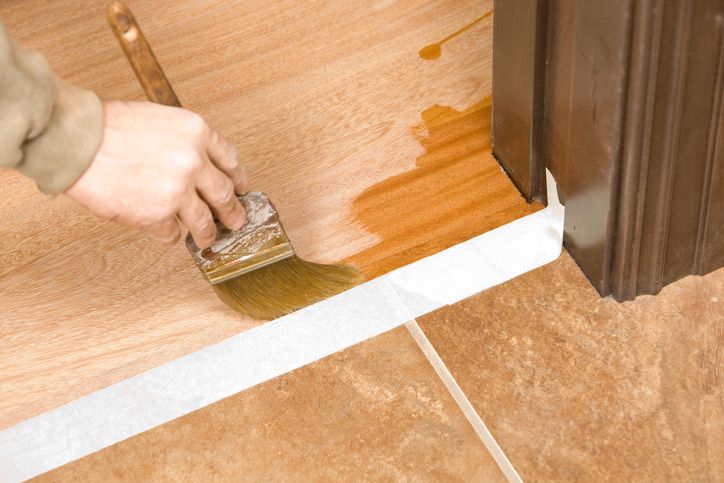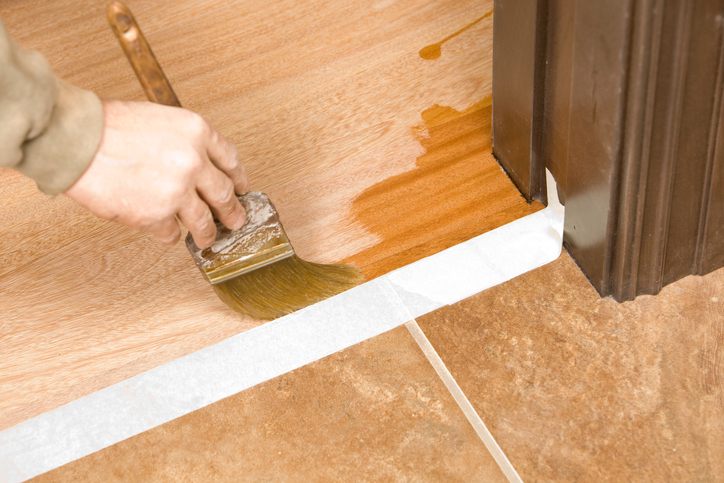 Bamboo plywood is rapidly becoming an interior design star for its beautiful appearance and its eco-friendly qualities. People use this versatile material to create accent walls, cabinetry, furniture, bathroom vanities, ceiling panels, and much more. Bamboo plywood, like bamboo flooring, is a popular building material for several reasons. First, once the bamboo is harvested, it is easily and quickly regrown, taking a mere 4 years to reach maturity instead of several decades for trees, making it an eco-friendly alternative to standard plywood. Secondly, bamboo has above-average compressive and tensile strength, making it an extremely durable product. Many people wonder whether you can stain bamboo plywood before using it in a design project. The answer is “yes”! You can both stain and finish bamboo plywood just as you would ordinary plywood. In general, any stains and finishes which work well with medium density hardwoods work equally well with solid bamboo plywood.
Bamboo plywood is rapidly becoming an interior design star for its beautiful appearance and its eco-friendly qualities. People use this versatile material to create accent walls, cabinetry, furniture, bathroom vanities, ceiling panels, and much more. Bamboo plywood, like bamboo flooring, is a popular building material for several reasons. First, once the bamboo is harvested, it is easily and quickly regrown, taking a mere 4 years to reach maturity instead of several decades for trees, making it an eco-friendly alternative to standard plywood. Secondly, bamboo has above-average compressive and tensile strength, making it an extremely durable product. Many people wonder whether you can stain bamboo plywood before using it in a design project. The answer is “yes”! You can both stain and finish bamboo plywood just as you would ordinary plywood. In general, any stains and finishes which work well with medium density hardwoods work equally well with solid bamboo plywood.
PREPARING THE BAMBOO PLYWOOD FOR FINISHING
- Get a hygrometer (a small device that measures humidity and can be found for cheap online or at big box stores) and ensure you maintain a humidity level of between 40 and 60 percent. Set the thermostat in the area in which you’ll be staining your plywood somewhere between 50 and 90 degrees (F). Let the plywood sit in this environment for at least 3-7 days before beginning your work.
- Prepare your work surface by laying out a drop cloth or plastic sheeting to protect the surrounding surfaces from any drips from the stain and help keep any dust or debris on the floor from blowing up and settling on the surface of the plywood. Next, lay the plywood out flat on your work surface, taking care that it doesn’t overhang. (That’s because it’ll need some light sanding, and you want the sanding pressure to be equal along its entire length.)
STAINING THE BAMBOO PLYWOOD
Choose either an oil-based or water-based stain to finish your bamboo plywood panels (see finishes sections below). Avoid using a pigment stain as it generally produces a “blotchy” effect on bamboo plywood surfaces. It’s important to use a moisture-balancing stain since it naturally absorbs moisture and can swell if exposed to excessive humidity. Once you’ve chosen a high-quality wood stain in color you love, keep in mind that staining involves more than just opening a can of stain and getting to work …
- Lightly sand the panel surface with a sander and 100-150-grit sandpaper to remove spots and/or raised wood. (Wear a dust mask!) Afterward, wipe the surface with a clean, lint-free rag to remove any sanding dust. (Be sure to clear your work area of sanding dust afterward as well!)Use an air compressor to remove excess dust if needed.
- Some carpenters recommend rubbing a high-quality wood conditioner/pre-stain product onto the plywood’s surface and allow it to dry according to the instructions on the can. Once dry, you can very softly buffer the surface using extra-fine sandpaper, wiping clean again afterward. You’re now ready to stain.
- You can use a brush to apply the stain, if you wish, or use a rag. Either way, have a rag handy so that you can wipe off the excess stain after giving it some time to absorb. If you’re happy with the intensity of the color, you’re done with the staining. If you want it a bit darker, you can apply a second coat, but you can skip sanding between the first and second coats of stain. (Be sure to apply the stain in the direction of the grain!) Let the stain “cure” for several hours (up to 24) before applying the finish of your choice.
FINISHING THE BAMBOO PLYWOOD
Some people like to apply an additional layer of finish coat on top of the stain to protect your bamboo plywood from moisture. You can use oil, wax, or polyurethane to finish your bamboo plywood, but we always recommend testing these products on a sacrificial piece of plywood before proceeding with your project. Here’s a list of common finishes used on wood products that can also be applied to bamboo plywood.
- Mineral oil is an affordable option that will easily coat your plywood. Apply it liberally using a cloth, but avoid cheaper clothes because they might pill, and those tiny pieces of fabric are a pain to get off. You might even want to run the cloth through a wash cycle first to get off excess pillage. After the plywood is saturated, you can easily wipe off the excess oil. (Important: On surfaces where food will be prepared, avoid vegetable-based oil since it will degrade and quickly turn rancid and could subject you and your family to a nasty case of food poisoning!)
- Raw Linseed Oil is made from crushed flax seeds (not to be confused with boiled linseed). This oil has a longer curing time and must be frequently re-applied but provides a nice satin finish.
- Minwax Paste Finishing Wax works well and is safe even for surfaces that will contact food. Wax finishes aren’t as commonly used as oils but will be fine for indoor surfaces, although it does require some elbow grease to apply and buff to a sheen!
- Tung oil is also an option because it dries with a bit of gloss it’s generally water-resistant. It’s made from the nuts of china wood trees and used as the fundamental ingredient in many finish blends—harder to apply and require frequent re-coating but is somewhat more resistant to water than other finishes.
- Watco Danish Oil isn’t absorbed quickly but contains a little more natural variation than other finishes. You can achieve the desired level of sheen by adding more coats, but you’ll need to wait at least a day in between coats to allow it to dry. You can always go over the surface with super fine sandpaper to get a cleaner/smoother surface finish.
- Other types of finishes used are beeswax, carnauba wax, shellac, and walnut oil. Some of these finishes can also be mixed with mineral oil for different levels of consistency and sheen. As with all finishes, we recommend trying these out on a sacrificial piece to determine permeability, finish sheen, and water resistance.
- Oil and wax finishes don’t last as long as polyurethane finishes and will need to be re-applied at more frequent intervals.
Polyurethane finishes — whether oil or water-based formulas — are fine and come in finishes ranging from satin sheens to high-gloss shine, depending on your preference—brush on following the manufacturer’s instructions on the can.

About the Author
Jen is your go-to guru for crafting a cozy, green cocoon. 🪴 Her dive into sustainable building wasn’t just about saving the planet—it started as a mission to make family movie nights eco-friendly (and to ensure the popcorn was the only thing getting heated!). With a knack for breaking down the jargon, Jen turns eco-lingo into everyday language. Swing by the Green Living blog for a mix of earth-loving advice and home improvement hacks. Whether you’re just dipping your toes into green waters or you’ve been swimming in the deep end of DIY projects, Jen’s here to guide, giggle, and remind you that every eco-choice is a step towards a planet that thanks you… and maybe even sends a rainbow your way! 🌈

